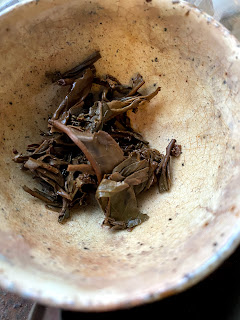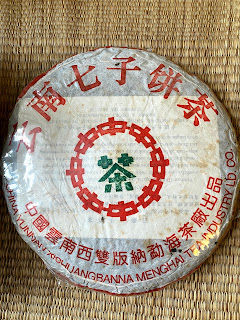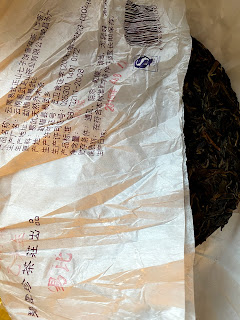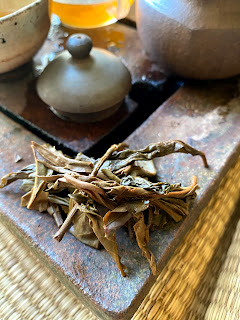

I know it’s really hard to believe now but it used to be
common to give and receive Lao Ban Zhang from other puerh drinkers and vendors
both online and around tea tables. Back
in the day Laobanzhang was not as crazy expensive as it is now. Relatively speaking it was still expensive- a
hundred or two for a cake at a time of $10-$30 cakes but it was at least attainable
for most. At the very least it was
impressive for a vendor to have some, it offered them a bit of validity and prestige. Laobanzhang was all the craze and at that
time you were a part of it. Around the
tea tables they would often bring it out at the end of a late session or after
a few impressive teas. Other tea
drinkers and online vendors would also post small samples of Laobanzhang in
early times. As a result, I had become inadvertently
acquainted with Laobanzhang despite my refusal to spend that much money on a
cake. It goes without saying that it has
been a long time since anyone has sent me or shared with me some Laobanzhang
and I haven’t any to enjoy out of my own stash… so it’s been a while…
Although I have some experience with fresh younger Lao Ban
Zhang from drinking it back in the day nobody was handing out 90s 14 year aged
Lao Ban Zhang at that time. So I
actually have very little experience with semiaged/aged Lao Ban Zhang. This sample of 2006 Xi Zhi Hao black wrapper (
$595.00 for 400g or $1.49/g) which soldout in classic Houde lightspeed will be a treat …
Dry leaves smell of faint mineral almost floral odour with a
very faint lingering of icing sugar sweetness.
The leaves look quite large with big stems.
The first infusion has a very creamy reverberatingly sweet
creamy candy full taste in the mouth. It
has a layered fluffy cloud like icing sugar sweetness in the mouth with a faint
touch of astringency that pushes the saliva over the flat almost fine course
tinging tongue feeling. The aftertaste
is a bit sweet and tart apple with candy and sticky throat sensations. This looks and tastes like a nice dry
Taiwanese storage that still retains a lot of nuanced sweetness and has that
classic incense base taste.
The second infusion has a woody, sweet cherry-apple taste
with candy layers, there is a strong incense taste and odour. The taste is very layered fluffy candy like
sweetness that is layered into a sweet and almost tart cherry-apple fruit taste
with a strong incense base taste. It has
a tingling face body feeling with a clear acuity sharpening energy. The mouthfeeling has a soft, almost sandy dry
texture which some thin layer of saliva spills over and sensation open into the
mid throat.
The third infusion has a floral candy fruity cherry-apple deep
layered and rich sweetness with strong incense onset. There is a building astringent bitterness
that is still quite mild. This liquor
has a nice oily texture over a soft but full almost granular tongue coating and
a mid-deep throat opening that pushes saliva into the upper throat. The aftertaste is a sweet incense taste with
a layer of candy and cherry sweetness hiding underneath. The Qi is strong and is pushing my mind into
a spaced out and stoned state. There is
a strong body feeling developing with Heart pumping and face tingling. The aftertaste leaves a mineral, kind of
incense, barely sweet lingering.

The fourth infusion has a moderate bitter-astringency
presenting first with some tart cherry like sweetnotes and candy. This infusion the astringent bitter onset is
the dominating taste with layers of cherry, wood, incense over a silty tongue feeling
and oily textured liquor on top which seems to pour out the top throat as the
mid throat is stimulated. Stronger
bitter astringent taste, strong excellent mouthfeeling and throatfeeling, and,
yes, strong Qi sensation of intense mind stimulation mixed with stoned feeling
and stupor. The bodyfeeling consists of
warming heart sensation as well and tingling.
The fifth infusion has a more rich layered sweetness that is
more of a woody-cherry sweetness over a candy like sweetness. There is a faint coolness, very faint as the
astringent bitterness and incense overtake the more sweetness again. The throat and mouthfeeling continue to do
what they have been doing above and are quite strong and stimulating. There is a mineral like taste left in the
mouth minutes later with incense. The Qi
is really intense and has a strong bodyfeeling- stoned, alerted, detached, HT
opening/slight warming with dizziness.
The sixth infusion has a rich cherry and candy presentation
now. The sweetness is shared with
bitter-astringency. The candy aftertaste
is more apparent now and the incense base is less overwhelming. There are almost peach-cherry notes appearing
in the aftertaste. Wow the Qi is so
strong and intense. It really shakes me
up. This infusion has a much more
intense saliva producing effect in my mouth that seems to hold the sweet tastes
much longer especially the candy-cherry sweetness. Best infusion so far. Still very strong.
The seventh infusion has a fruity tart apple incense wood
not as candy sweet onset that has a nice full layered richness to it. The candy more comes out in the aftertaste as
the incense woody notes builds up. The
sweetness starts at onset and stretches out more uninterrupted by
astringent-bitterness like it did in the last handful of infusions now. The Qi is alerting yet calming. The tongue feels a full soft almost chalky
fine sand with an oily liquor. The
throat is less astringent-simulated but more softly stimulated like an opening
in the mid throat where saliva pools up in the upper throat and mouth.
The 8th infusion has an almost soapy floral onset
which is the most distinct of the flavours here. There is a bit of candy but very faint now
and some woody incense which is still significant. The bitter-astringency has dropped down over
the last few infusions to something more mild-moderate. The mouthfeeling and throat feeling is much
the same as last infusion with a waning oily texture but with a fluffy
stimulation of the throat and saliva producing effect. Nice euphoric relaxation now with stimulating
acuity and Heart sensations.
The 9th has a buttery-creamy candy sweet onset
with a strong incense backbone. There is
a nice silty mouthfeeling with a distinct incense and candy finish with a
stronger mineral chalky taste in the finish minutes later. The bitter and astringency is very mild here
leaving more of a long candy with incense taste. Nice euphoria and feel good Qi.
The 10th infusion has a nice creamy candy sweet
taste with mineral finish the viscosity is going down here. A nice thinner full fine sandy coating. The taste and mouthfeeling and texture is
declining here but the Qi is still pretty strong- it’s more euphoric and in the
mind and less in the body though.
11th has a mainly incense wood not with an
interesting clear pear taste upfront.
The taste has become much simpler here but still quite satisfying and
decently long. There is a chalky almost
mineral aftertaste now not much sweetness.
12th has a incense note up front there is not
much for other tastes other than some faint mineral, faint wood, very faint
candy, very faint pear with that being said it is not insipid because the
strong incense taste is stable and long throughout with still some full but
thinning mouthcoating but much less throat feeling now. Nice calming Qi.
13th has an almost candy sweet and incense
onset. The incense taste is the dominant
one throughout the profile with some hints at candy sweetness underneath. The
mouthfeel continues to wane as does the throatfeeling. There is a mineral, incense stickiness in the
mouth afterwards.
I decided to push this one a bit with longer steepings…
I use a 15 second over flash infusion for the 14th
… it pushes a stronger incense taste out with a bit more mineral and faint
sweetness. The result is a bit longer
and faintly sweeter but mainly just incense finish. There is also a deeper throat taste than the
last handful of infusions too. The Qi is
a bit euphoric and relaxing and has a strong headiness type of dizziness
happening.
The 15th I do a 25 second steeping… it is mainly
just a strong woody incense note with much more floral notes coming out
now. There is a mineral finish with not
really any sweetness and a bit of floral.
The mouthfeeling is stickier on the lips and tongue with a bit of throat
mid- stimulation which seems to attract a floral mixed with incense aftertaste.
16th is a 40 seconds steeping and has a creamy
almost candy woody incense taste that feels chalky and full with suggestions of
candy, minerals, and almost pear tastes.
Calm focused and happy energy prevails.
17th is 60 seconds and is still quite strong and
condensed woody incense with subtle suggestions of mineral, candy, pear over a
flat sticky mouthfeeling.
18th is a minutes long steeping the liquor is
then left to cool and it tastes so delicious… like Lucky Charms marshmallow
cereal with a long sweet candy body and still significant full incense
taste.
The mug steepings keep giving off great tastes long strong marshmallow
candy like sweetness with a substantive incense base taste.

This is a nice LaoBanzhang for the price and those that
jumped on this one fast were rewarded with some really nice dry storage as
well that really accentuates the long strong sweet candy tastes. Houde’s dry storage has done this cake very well and those that took the plunge on this one might have near optimal storage. Good job!
Peace

































